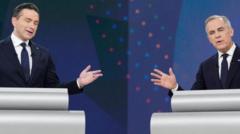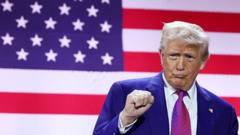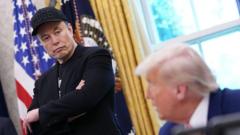The leaders of Canada's four primary political parties participated in their concluding debate ahead of the approaching general election, where the spotlight unexpectedly shifted to U.S. President Donald Trump. Liberal leader Mark Carney, currently leading in polls, faced scrutiny from his counterparts—Conservative leader Pierre Poilievre, New Democratic Party leader Jagmeet Singh, and Bloc Québécois leader Yves-François Blanchet. Key issues discussed included trade relations with the U.S., crime, and the high cost of living. Here are five crucial insights from the debate:
Debate Highlights: Key Moments from Canada's Leaders' Showdown

Debate Highlights: Key Moments from Canada's Leaders' Showdown
In the second and final debate before the Canadian general election, party leaders faced off on major issues, with surprising moments overshadowed by external influences.
1. Trudeau's Legacy Lingers: Carney found himself defending his position against the detrimental legacy of former Prime Minister Justin Trudeau. Poilievre criticized the Liberal party's past decade in power, referencing issues like skyrocketing housing prices. "How can we believe you will be different?" he questioned Carney, who reiterated his fresh start within the party.
2. Navigating Trump Relations: The debate addressed how each leader would handle tariffs imposed by Trump. Carney acknowledged the economic disparity, mentioning that Canada could no longer rely on "dollar-for-dollar" tariff responses. He explained that the strategy would transition towards targeted tariffs aimed at minimizing damage to Canadian interests while still addressing U.S. actions.
3. Focused on Policy Substance: The conversation veered towards pivotal issues affecting Canadians—from healthcare to immigration. Poilievre advocated for low taxes and small government, while Singh promoted extensive social programs, sparking a clear delineation of party ideologies. Carney maintained a centrist standpoint, emphasizing the government's catalytic role in addressing crises.
4. Lesser Parties' Fight for Relevance: The political landscape featured four main parties, with third-party candidates like Singh's New Democrats facing potential existential threats due to low polling rates. Singh attempted to assert his party's presence despite interruptions and expressed the importance of not placing total power in Carney's hands. The Bloc leader strategically inserted Quebec-centric issues throughout the debate.
5. Maintaining Civility Amidst Tension: Despite moments of disagreement, the overall atmosphere was respectful compared to previous debates, whether in Canada or the U.S. Carney displayed restraint during heated exchanges, maintaining decorum. Both Carney and Poilievre were seen amicably shaking hands afterward, highlighting a notable difference in conduct.
As the election nears, Canadians will ultimately decide between these contrasting visions for their future.
2. Navigating Trump Relations: The debate addressed how each leader would handle tariffs imposed by Trump. Carney acknowledged the economic disparity, mentioning that Canada could no longer rely on "dollar-for-dollar" tariff responses. He explained that the strategy would transition towards targeted tariffs aimed at minimizing damage to Canadian interests while still addressing U.S. actions.
3. Focused on Policy Substance: The conversation veered towards pivotal issues affecting Canadians—from healthcare to immigration. Poilievre advocated for low taxes and small government, while Singh promoted extensive social programs, sparking a clear delineation of party ideologies. Carney maintained a centrist standpoint, emphasizing the government's catalytic role in addressing crises.
4. Lesser Parties' Fight for Relevance: The political landscape featured four main parties, with third-party candidates like Singh's New Democrats facing potential existential threats due to low polling rates. Singh attempted to assert his party's presence despite interruptions and expressed the importance of not placing total power in Carney's hands. The Bloc leader strategically inserted Quebec-centric issues throughout the debate.
5. Maintaining Civility Amidst Tension: Despite moments of disagreement, the overall atmosphere was respectful compared to previous debates, whether in Canada or the U.S. Carney displayed restraint during heated exchanges, maintaining decorum. Both Carney and Poilievre were seen amicably shaking hands afterward, highlighting a notable difference in conduct.
As the election nears, Canadians will ultimately decide between these contrasting visions for their future.






















